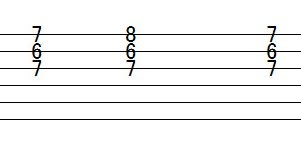「Seven Goblins」同様何十年経った最近気づいたショッキングな出来事😢
A shocking incident that I noticed recently after many decades.
初心者の頃は音楽理論やスケールの知識が全くなかったので気づかなかったし楽譜にも書いてなかった
When I was a beginner, I had no knowledge of music theory or scales, so I didn't notice it and it wasn't written in the sheet music.
これも2年前に考察記事でディープに掘り下げたのですが再現不可能なので「sevengoblins」同様結末のみ書きます
I also delved into this in a review article two years ago, but since it is impossible to reproduce it, I will only write about the ending, similar to "sevengoblins".
☀New!!《※なおこの再投稿記事制作中に新たに1つ発見してしまいました😲! 後半⇩に追記しました》
~By the way, I discovered one new thing while creating this reposted article! Added in the second half ⇩
この部分の上昇フレーズ3連続ですが、、
Regarding the rising phrase in this part appearing three times...
A

B

C

・・とこのように一見同じスケールで3回上昇してるように見えるのでつい”C”のように弾いてしまいがちですし
学生時代に見た楽譜にもこう書いてありました(友人もこのように弾いてました)
...and since it looks like it's rising three times on the same scale, it's easy to end up playing it like a "C".
This is what was written in the sheet music I saw when I was a student (my friend also played it this way)
でも実際はこうなっていました⇩(3コ目の音が16→15フレット)
But it actually turned out like this ⇩ (the third note is from fret 16 → fret 15)
C

※この部分(小節)のコードを調べると理由が判明してきます
そして他の部分もコードに合わせて巧みに「D#音↔D♮音」の構成がなされています
ゆっくりな部分は分かりやすいですが速弾き部分はつい見落としてしまいがちなので耳コピする時には
注意が必要だと改めて感じました😢
*If you look at the chord in this part (measure), you will understand the reason.
The other parts are also skillfully constructed to match the chord: "D# note ↔ D♮ note".
The slow parts are easy to understand, but the fast parts are easily overlooked, so I realized once again that I need to be careful when copying by ear.
そしてこのようなポジションで弾いているのを動画で確認しました⇩
And I confirmed in the video that it is played in this position ⇩

《追記/P.S.》
そしてそのあとの2弦16フレットですが、ここはまだ小節が変わってない(!)ので
And the measure has not changed yet at the 16th fret of the 2nd string...

⇩

・・とこのように15フレットになっていました
So this will be the 15th fret.
(見落としていました😢I overlooked it) ・・「D#音↔D♮音」
その後小節が変わるので(⇩下のTAB譜でいうと3弦18フレットから)
次に出現するD音は15フレットではなく16フレットになっています
After that, the measure changes (from the 18th fret of the 3rd string according to the TAB score below)
The next D note is on the 16th fret instead of the 15th.

冷静に考えれば気づけたポイントですね😢、、
でも気づけて良かったです
This is a point I realized if I thought about it calmly.
But I'm glad you noticed
いつかフルカバーする時には気をつけたいと思います🐱
I would like to be careful when I do full cover someday.
(・・たぶんしない..w)
(…I probably won’t play it though…lol)
・・長いソロを覚えるのが大変...(*⁰▿⁰*)
...Long solos are difficult to remember...
...オボエナサイ!!(( ’-’)ノ)’-’)))ペシッ!!!
...Just put up with that! (LOL)...(( ’-’)ノ)’-’)))slap!!!
🐰🐱
過去の練習・・
《追記/P.S.》
曲のKeyがEなので基本は
Eメジャースケール(=C#マイナースケール)、そして
E(onD)のとき=E mixolydian(=F#マイナースケール)
D7のとき=D mixolydian(=Eマイナースケール)
・・となると3つのマイナースケールで覚えるという手もありますね
The key of the song is E, so basically
E major scale (=C# minor scale), and
When E(onD)=E mixolydian(=F#minor scale)
When D7 = D mixolydian (=E minor scale)
In other words,
You can remember it like this...
⇩
3 minor scales


















